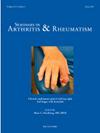Risk and temporal trends of heart failure subtypes in rheumatoid arthritis
IF 4.4
2区 医学
Q1 RHEUMATOLOGY
引用次数: 0
Abstract
Objective
Evaluate the risk and temporal trends of heart failure (HF) with preserved (HFpEF) and reduced ejection fraction (HFrEF) in rheumatoid arthritis (RA).
Methods
We performed a retrospective, matched cohort study using Veterans Health Administration (VHA) administrative and health record data from 2000 to 2019. Patients with RA were matched up to 10 non-RA controls on age, sex, and VHA enrollment year. Incident HF and HF-related death were queried, classifying HFpEF and HFrEF using left ventricular EF data from a validated natural language processing tool. HF risk was evaluated using conditional Cox regression, adjusting for demographics, body mass index, smoking, rurality, healthcare utilization, and comorbidity burden. Trends in HF risk were evaluated, stratifying models by RA diagnosis period (2000-2005, 2006-2011, 2012-2017).
Results
We matched 67,850 patients with RA (mean age 62.5, 87.1 % male) to 570,933 non-RA controls (mean age 61.1, 85.8 % male). HF prevalence increased in both groups over time. Over 5,663,151 person-years of follow-up, 77,440 incident HF diagnoses occurred. RA was associated with an increased risk of HFpEF (aHR 1.51, 95 % CI 1.46-1.57) and HFpEF-related death (2.05, 1.76-2.39), as well as HFrEF (1.34, 1.30-1.38) and HFrEF-related death (1.45, 1.29-1.63). HF risk was accentuated in RA patients with elevated inflammation and seropositive RA. No improvements in HF risk were observed over time (linear p-for-trend >0.05 for all outcomes).
Conclusion
RA was most strongly associated with HFpEF and HFpEF-related death in this national-level, observational dataset. Heightened risks of HF subtypes have not improved despite advances in RA treatment. Prospective research is needed to support the development ofprevention and management strategies to mitigate HF risk in RA.
类风湿关节炎中心衰亚型的风险和时间趋势
目的评价类风湿关节炎(RA)患者保留心力衰竭(HFpEF)和射血分数降低(HFrEF)心力衰竭(HF)的风险和时间趋势。方法利用2000年至2019年退伍军人健康管理局(VHA)的行政管理和健康记录数据进行回顾性、匹配队列研究。根据年龄、性别和VHA登记年份,将RA患者与10名非RA对照配对。查询事件HF和HF相关死亡,使用经过验证的自然语言处理工具的左心室EF数据对HFpEF和HFrEF进行分类。使用条件Cox回归评估HF风险,调整人口统计学、体重指数、吸烟、农村、医疗保健利用和合并症负担。根据RA诊断期(2000-2005年、2006-2011年、2012-2017年)对HF风险趋势进行评估,并对模型进行分层。结果:67,850例RA患者(平均年龄62.5岁,男性87.1%)与570,933例非RA对照组(平均年龄61.1岁,男性85.8%)相匹配。随着时间的推移,两组心衰患病率均有所增加。在5,663,151人年的随访中,发生了77,440例心衰诊断。RA与HFpEF (aHR 1.51, 95% CI 1.46-1.57)和HFpEF相关死亡(2.05,1.76-2.39)以及HFrEF(1.34, 1.30-1.38)和HFrEF相关死亡(1.45,1.29-1.63)的风险增加相关。在炎症升高和血清RA阳性的RA患者中,HF的风险增加。随着时间的推移,没有观察到HF风险的改善(所有结果的线性p-for-trend >;0.05)。结论:在这个国家级的观察数据集中,ra与HFpEF和HFpEF相关死亡的相关性最强。尽管类风湿性关节炎的治疗取得了进展,但HF亚型的高风险并未得到改善。需要前瞻性研究来支持预防和管理策略的发展,以降低RA的HF风险。
本文章由计算机程序翻译,如有差异,请以英文原文为准。
求助全文
约1分钟内获得全文
求助全文
来源期刊
CiteScore
9.20
自引率
4.00%
发文量
176
审稿时长
46 days
期刊介绍:
Seminars in Arthritis and Rheumatism provides access to the highest-quality clinical, therapeutic and translational research about arthritis, rheumatology and musculoskeletal disorders that affect the joints and connective tissue. Each bimonthly issue includes articles giving you the latest diagnostic criteria, consensus statements, systematic reviews and meta-analyses as well as clinical and translational research studies. Read this journal for the latest groundbreaking research and to gain insights from scientists and clinicians on the management and treatment of musculoskeletal and autoimmune rheumatologic diseases. The journal is of interest to rheumatologists, orthopedic surgeons, internal medicine physicians, immunologists and specialists in bone and mineral metabolism.

 求助内容:
求助内容: 应助结果提醒方式:
应助结果提醒方式:


